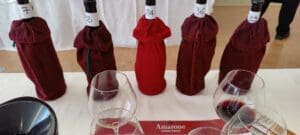Last month, Cellarmaster Wines engaged me to present the wines of Gerardo Cesari at a Gusto Italiano dinner. It was a sold-out dinner with a long waiting list. Considering Singapore’s insatiable thirst for Amarone, we can probably do two dinners and still manage a sellout. Better yet, this makes my work a lot easier, since these wines will sell themselves without a nudge. But what the diners did not expect for that evening was our plan to nosedive from a high point at the end of dinner. So what was it? After two glasses of robust Amarone, we gave a dry red wine to pair with the dessert.
Yes, many of them probably thought it was our boo-boo to have a dry red wine pairing with a chocolate-based tart. Some made their opinion known to me, others were a little more subtle. I can certainly empathise with their let-down. But no one said things ought to go by the book, and I was secretly glad we didn’t. The dry red wine was a revelation.
The dry red wine here was Gerardo Cesari’s Jema 2011. A wine made only from Corvina that undergone short duration air-drying before fermentation. This was then followed by a long duration of barrel and cask ageing before held in the bottle for another year. The resulting wine was fresh with acidity, red cherries fruitiness, light floral spice, and pointy like a Pharoah’s pyramid. It stood on the palate with a stark contrast to Amarone roundness. The wine, like a headstrong child, wasn’t trying to be chummy with anyone.
“This Corvina is l’anima della Valpolicella. The soul of Valpolicella!” And that was the most important message for the evening.
The Corvina grape
Despite all the full-bodied, chocolate and spicy richness we tasted out of Amarone, the very heart of Valpolicella still revolves around Corvina. As a grape variety, a well-ripen Corvina can hardly have enough sugar content to meet the desired alcohol level. With a thick skin that can withstand air-drying over three to four months, winemakers dry Corvina to make a richer wine which would otherwise be not possible. But more importantly, Corvina uniqueness is the natural characteristic of well suited for air-drying. University researchers had discovered that a chemical reaction takes place inside the grape during the drying process which creates a higher level of glycerin which contributes significantly to the roundness and sense of sweetness in the mouthfeel.
There aren’t many single variety wines from Corvina, but Cesari’s Jema is not unique either. Allegrini’s La Poja, Zenato’s Cresasso, and Tinazzi Corvina are examples of pure Corvina wines around in the market. Although the bottle labels read IGT, many do command a premium price tag. Again another proof that IGT is not a bad word on wine bottles.



